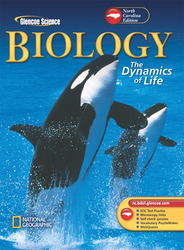 
Biology: The Dynamics of Life, North Carolina EditionChapter 1:
Biology: The Study of LifeWeb Links
| Click the Techie Toolbox for tips and help to make the most of your time on the Web.
 <a onClick="window.open('/olcweb/cgi/pluginpop.cgi?it=gif::::/sites/dl/free/0078675642/181784/techietoolbox.gif','popWin', 'width=NaN,height=NaN,resizable,scrollbars');" href="#"><img valign="absmiddle" height="16" width="16" border="0" src="/olcweb/styles/shared/linkicons/image.gif"> (2.0K)</a> <a onClick="window.open('/olcweb/cgi/pluginpop.cgi?it=gif::::/sites/dl/free/0078675642/181784/techietoolbox.gif','popWin', 'width=NaN,height=NaN,resizable,scrollbars');" href="#"><img valign="absmiddle" height="16" width="16" border="0" src="/olcweb/styles/shared/linkicons/image.gif"> (2.0K)</a>
p. 2
 <a onClick="window.open('/olcweb/cgi/pluginpop.cgi?it=gif::::/sites/dl/free/0078675642/181784/biology_online.gif','popWin', 'width=NaN,height=NaN,resizable,scrollbars');" href="#"><img valign="absmiddle" height="16" width="16" border="0" src="/olcweb/styles/shared/linkicons/image.gif"> (1.0K)</a> <a onClick="window.open('/olcweb/cgi/pluginpop.cgi?it=gif::::/sites/dl/free/0078675642/181784/biology_online.gif','popWin', 'width=NaN,height=NaN,resizable,scrollbars');" href="#"><img valign="absmiddle" height="16" width="16" border="0" src="/olcweb/styles/shared/linkicons/image.gif"> (1.0K)</a>
| | What Is Life? | | This site is a "homework help" index. Jiskha Homework Help (JHH) is student managed and has a number of contributing authors and editors. From the Science: Biology page, scroll down to find out the 5 main characteristics of all living things.
(
http://www.jiskha.com/science/biology/
) |  |  |  | | Living Things | | This page describes different aspects and categories of living things. Visit the Creativity section and develop a project based on these suggestions.
(
http://www.fi.edu/tfi/units/life/
) |  |  |  | | Shadow a Swan Project -- Utah Education Network | | Learn about the lives of several Tundra swans at this Web site. Meet the swans and follow their movements. How are the swans tagged? How are their locations determined? Register to participate fully in the project or drop in periodically to check on each swan's progress. For more education resources visit the Utah Education Network at www.uen.org.
(
http://www.uen.org/swan/
) |  |  |  |
p. 24
 <a onClick="window.open('/olcweb/cgi/pluginpop.cgi?it=gif::::/sites/dl/free/0078675642/181784/biolab.gif','popWin', 'width=NaN,height=NaN,resizable,scrollbars');" href="#"><img valign="absmiddle" height="16" width="16" border="0" src="/olcweb/styles/shared/linkicons/image.gif"> (1.0K)</a> <a onClick="window.open('/olcweb/cgi/pluginpop.cgi?it=gif::::/sites/dl/free/0078675642/181784/biolab.gif','popWin', 'width=NaN,height=NaN,resizable,scrollbars');" href="#"><img valign="absmiddle" height="16" width="16" border="0" src="/olcweb/styles/shared/linkicons/image.gif"> (1.0K)</a>
| | The Seven Characteristics of Living Things | | This site discusses the seven characteristics of all living things. Click on the Questions and Quizzes relating to this chapter link to test your knowledge. Compare the characteristics listed on this site with those found on the other sites listed. How are they different? What characteristics are common among all of the sites.
(
http://www.saburchill.com/chapters/chap0001.html#Reproduction
) |  |  |  | | Characteristics of Living Things II | | This site explains the characteristics of living things too. Scroll to the bottom of the page and see if you can answer all of the questions on this web site.
(
http://marshallteachers.sandi.net/teacher_sites/mcquillan/02.WhatisLife/Readings/Char_Living.html
) |  |  |  | | Characteristics of Living Things III | | This site lists the characteristics common to all living things. Click on the brightly colored words to link to a different page that discusses the highlighted topic.
(
http://www.spacesciencegroup.nsula.edu/sotw/newlessons/defaultie.asp?Theme=ecology&PageName=livingcharacter
) |  |  |  |
p. 26
 <a onClick="window.open('/olcweb/cgi/pluginpop.cgi?it=gif::::/sites/dl/free/0078675642/181784/forming_opinion.gif','popWin', 'width=NaN,height=NaN,resizable,scrollbars');" href="#"><img valign="absmiddle" height="16" width="16" border="0" src="/olcweb/styles/shared/linkicons/image.gif"> (1.0K)</a> <a onClick="window.open('/olcweb/cgi/pluginpop.cgi?it=gif::::/sites/dl/free/0078675642/181784/forming_opinion.gif','popWin', 'width=NaN,height=NaN,resizable,scrollbars');" href="#"><img valign="absmiddle" height="16" width="16" border="0" src="/olcweb/styles/shared/linkicons/image.gif"> (1.0K)</a>
| | Are organic foods safer? | | This site answers this question and discusses the nutritional value of organic and conventionally produced foods. Click on the link to find out if organic foods have a better taste. Follow the link on this page to find out the truth about organic food myths.
(
http://www.sit.wisc.edu/~elkobriger/Nutrition.htm
) |  |  |  | | New USDA Standards for Labeling Organic Foods | | The U.S. Department of Agriculture has developed standards that must be used before a food product can be labeled organic. Go to this site to find more information about these regulations. This site contains several links for more information about organically grown foods.
(
http://www.pbs.org/newshour/bb/health/july-dec00/organic_12-21.html
) |  |  |  | | Food Irradiation | | Does food irradiation result in safer food? This web site discusses how irradiating foods can kill harmful pathogens. Click on the link for current information on food safety to find the most current information.
(
http://www.fda.gov/opacom/catalog/irradbro.html
) |  |  |  |
p. 28
 <a onClick="window.open('/olcweb/cgi/pluginpop.cgi?it=gif::::/sites/dl/free/0078675642/181784/real_world_bio.gif','popWin', 'width=NaN,height=NaN,resizable,scrollbars');" href="#"><img valign="absmiddle" height="16" width="16" border="0" src="/olcweb/styles/shared/linkicons/image.gif"> (1.0K)</a> <a onClick="window.open('/olcweb/cgi/pluginpop.cgi?it=gif::::/sites/dl/free/0078675642/181784/real_world_bio.gif','popWin', 'width=NaN,height=NaN,resizable,scrollbars');" href="#"><img valign="absmiddle" height="16" width="16" border="0" src="/olcweb/styles/shared/linkicons/image.gif"> (1.0K)</a>
| | Human Cloning | | How do you clone a human? Follow the links on this site to discover how human cloning may be accomplished.
(
http://www.howstuffworks.com/human-cloning.htm
) |  |  |  | | Cloning Dolly, the Sheep | | This site discusses the process that was used to clone Dolly, the sheep, and how this process may be used to clone humans. Follow the links to read about this hot topic.
(
http://www.cs.virginia.edu/~jones/tmp352/projects98/group1/how.html
) |  |  |  | | How soon will a human be cloned? | | This site discusses this question in detail in an interview with a professor of genetics. Click on links & readings to find more information on human cloning.
(
http://www.pbs.org/wgbh/pages/frontline/shows/fertility/etc/cloning.html
) |  |  |  |
 |  |
|







